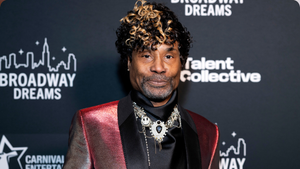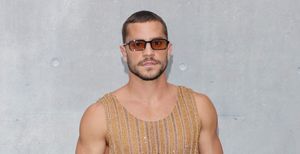Boldly responding to North Carolina Gov. Pat McCrory's Wednesday decision to sign House Bill 2, which repeals LGBT public accommodations protections -- a move explicitly made to keep trans people, and especially trans women, from accessing public bathrooms and locker rooms that match their gender identity -- one trans activist tweeted a striking selfie at the governor. In this tweet, the trans man's face was bearded and scowling; below it, the caption read, "It's now the law for me to share a restroom with your wife." The tweet has now been shared over 6,000 times.
As a political tactic, this tweet -- a move, by the way, that has been made by numerous other trans men, though to less widespread effect -- reads like pure gold. It hits at a gut, emotional level that most people who are unacquainted with gender politics can immediately understand. It makes the message clear: By repealing these protections, Gov. McCrory, you're creating the very situation you claim to eradicate (that is, when you and your followers inaccurately posit that trans women are "men" entering women's rooms). That visceral, visual instant messaging can quickly change hearts and minds. It makes a certain intuitive sense; it's smart triage.
So understandably, as I write, and each hour since the news of the North Carolina injustice began spreading, I've seen trans men taking to social media with images and words like this, and have seen even more allies taking up the cry, sending out pictures of burly, bearded trans men -- usually models and entertainers like Ian Harvie, Aydian Dowling, Buck Angel, Shawn Stinson, and Laith Ashley -- with captions like "With bathroom bills passed, trans men like these are forced into the women's room."
I've seen trans folks -- men, women, and other genders -- encouraging trans men to spread these images on social media. And while I've been heartened to see trans men critically engaging with online activism, the tenor of the conversation has made me uneasy. Before I jump into why, though, I do want to acknowledge here the courage that it takes for these trans men to make themselves visible for the cause. This is not a personal strike against them, for this tactic is effective by many short-term measures, as seen by the positive conversations it's stirred up.
However, as the heat of our responses to HB 2's injustice starts to cool down, I want to look carefully at this tactic, and ask what kind of long-term work it does. Even with hearts in the right place, the unintended results may make us want to think twice before perpetuating such ideas about trans men, trans bodies, and perceived threats. What other, underlying messages do they quietly send?
Mainly this: Trans men are scary. In raising the specter of "trans man as predator," messages like "It's now law for me to share the bathroom with your wife" code trans men as (physical, sexual) threats to women. This can be momentarily effective, displacing the hatred toward trans women onto actual male targets -- but in the end, it simply conjures up more fear. Fear, the opposite of love, is the emotion that causes the most damage in our world, and there are always unintended consequences when it is evoked, even when evoked in the name of the greater good.
Interestingly, trans men are voluntarily demonizing ourselves without folks like McCrory doing so; indeed, in all of the anti-trans "bathroom bill" rhetoric, trans men are not considered at all. These bills are explicitly crafted to target trans women, to police who is "allowed" to call themselves a woman and take up women's space. As with much policing of womanhood and femininity in our patriarchal culture, legislative bathroom policing has one stance toward trans men: It cannot imagine us. It cannot fathom a person "born female" who relinquishes that role and who lays claim to men's space. Our unfathomability has kept us largely safe from explicit bathroom panic, feeding an invisibility that makes our sudden visibility through "Trans men in women's bathrooms, oh no!" social media posts a surprising, powerful punch.
Yet these visual appeals that imply trans men will now suddenly start appearing in women's bathrooms are fundamentally inaccurate in two ways: First, because many trans men have always been using women's bathrooms out of necessity, and, second, because it implies that trans men who have been heretofore using men's restrooms will actually heed this law and start using women's restrooms. Both assumptions erase lived reality, preferring to appeal to what this law will theoretically demand trans men do. Yet the vast majority of trans men, like all other trans people, do not choose restrooms based on what the law says, but based on safety.
In the wake of a bill like HB 2 passing, trans men will most likely use public bathrooms the same way we have already been using them -- to get our business done with as little hassle as possible. In the bathroom, strangers only judge whether others "belong" in that space based on visible signifiers of gender -- like amount of facial hair, chest size, and height -- rather than genitalia. Speaking from personal experience and after talking to many trans men, I find that we tend to use men's rooms when we "pass" and know we are perceived by others to be male, and we use women's rooms when we believe others see us as women; we judge each situation by context or hold our bladders when we cannot tell whether we're pegged "male" or "female." Doing any differently than this would open us up to scrutiny, harassment, and even possible physical violence from other patrons, security guards, staff, and police. And even when "passing" as male in a men's room, legitimate fears can remain -- say, from my own experience, when I cannot conceal the sound of opening a tampon. Thankfully, North Carolina's law hasn't (yet) created a draconian measure that would allow others to scrutinize birth certificates, genitalia, or chromosomes to decide who gets to use which bathroom, as Carlos Maza of Media Matters for America points out.
Spreading images of bearded, masculine, "passing" trans men -- men like myself -- as the trans men who will now instantaneously be peeing next to folks like Gov. McCrory's wife inadvertently erases the reality that there are vast numbers of trans men who do not look like this. There are legions of trans men and nonbinary trans-masculine people who do not "pass," either because they cannot or do not wish to access medical transition. These are the trans men who have been peeing next to women in women's restrooms (and pose no threat while doing so) and will continue to. These are the trans men so often left out of trans discourse or the public imagination, when trans men are mentioned at all.
I should point out that negative effects from images of "passing" trans men can still happen despite the fact that the images have other positive effects: for instance, disrupting the idea that you can always tell a person's trans just by looking. Images do multiple kinds of work. It's impossible to judge "better" or "worse" in every single context, so I'm simply advising caution and awareness. We must be careful, in our zeal to bring sense to our detractors or potential allies, that we don't erase the diversity and subtleties within trans-masculine communities. Trans men who do not pass as male are often the ones among trans-masculine folks who bear the brunt of anti-trans-masculine violence, and those of us who "pass" are beholden to not fuel any systems to contribute to their erasure. One way to do this is, much like the original tweeter I quote at the beginning of this essay, would be to offer a more nuanced analysis of the complex issues at stake when given the space to do so, to counteract the proliferation of assumptions that gather around the structurally unnaunced nature of quick pics and 140-character tweets.
Questions of erasure and whose images are seized upon to stand in for the whole brings me to my final concern about the unintended consequences of these well-meaning "trans men in women's bathrooms" images: They fundamentally uphold the gender binary, and a logic that says we all must look a certain way to "belong" in certain bathrooms. As a short-term response, these messages may be powerful, but looking at the longer-term, larger vision -- which is what we all eventually must do, to fundamentally assure a safer, more just world for all trans people (and all people, period) -- we must push back on the real threats here.
When it comes down to it, the "bathroom panic" misdirected at trans women is about women and girls being vulnerable to sexual assault from men in public spaces (a threat, by the way, that many trans men who are misgendered as women are equally open to). These concerns are somehow twisted into making trans women into scapegoats for a much larger anxiety about cisgender (nontrans) men, meaning that anything that undermines trans women's safety is also of primary concern here. Perpetuating any messages that suggest folks, including trans women, must look a certain way to access a bathroom does not contribute to safety; anything that keeps us looking elsewhere than at how to end the sexual assault of women by men also does not contribute to resolving this issue once and for all.
Let's weigh carefully whether it's worth it to win a smaller battle at the expense of obscuring or overlooking what needs to be done to win the "war." Ultimately, it's up for each trans man to decide how he wants to address injustice, and my hat's still off to the men who decide to post images of themselves during this North Carolina aftermath. It's never a minor thing to out oneself publicly in a climate such as this, and the potential bathroom threats to trans men from those who know their trans status, regardless of which restroom they use, is often overlooked in conversations like this that focus largely on "stranger danger." If trans men engaging in visual activism consider the greater context to the issue that I provide here and choose the same or different actions in the future, I accept that too. We're all doing the best we can, and we cannot triumph without having each other's backs, even when we make differing choices. We can only keep assessing and talking.
MITCH KELLAWAY is a white biracial queer trans man who is the editor of Boys Do Cry, both an essay series on violence toward trans men and a forthcoming book from Homofactus Press (2017), and coeditor of Manning Up (2014, Transgress Press), an anthology of trans men's stories of connection. He spent a year as the trans issues correspondent for Advocate.com. Reach him at MitchKellaway.com and @MitchKellaway.
Kellaway would like to thank Kortney Ryan Ziegler, Jack Hollis Marr, Jules Sherred, Chase Strangio, James Parker Sheffield, Jen Richards, Tiq Milan, Elliott Finley Wake, Michael Hughes, Jack, Kevin, Keffy, and many others whose online discussions of this topic have helped hone his thinking.




































































Charlie Kirk DID say stoning gay people was the 'perfect law' — and these other heinous quotes